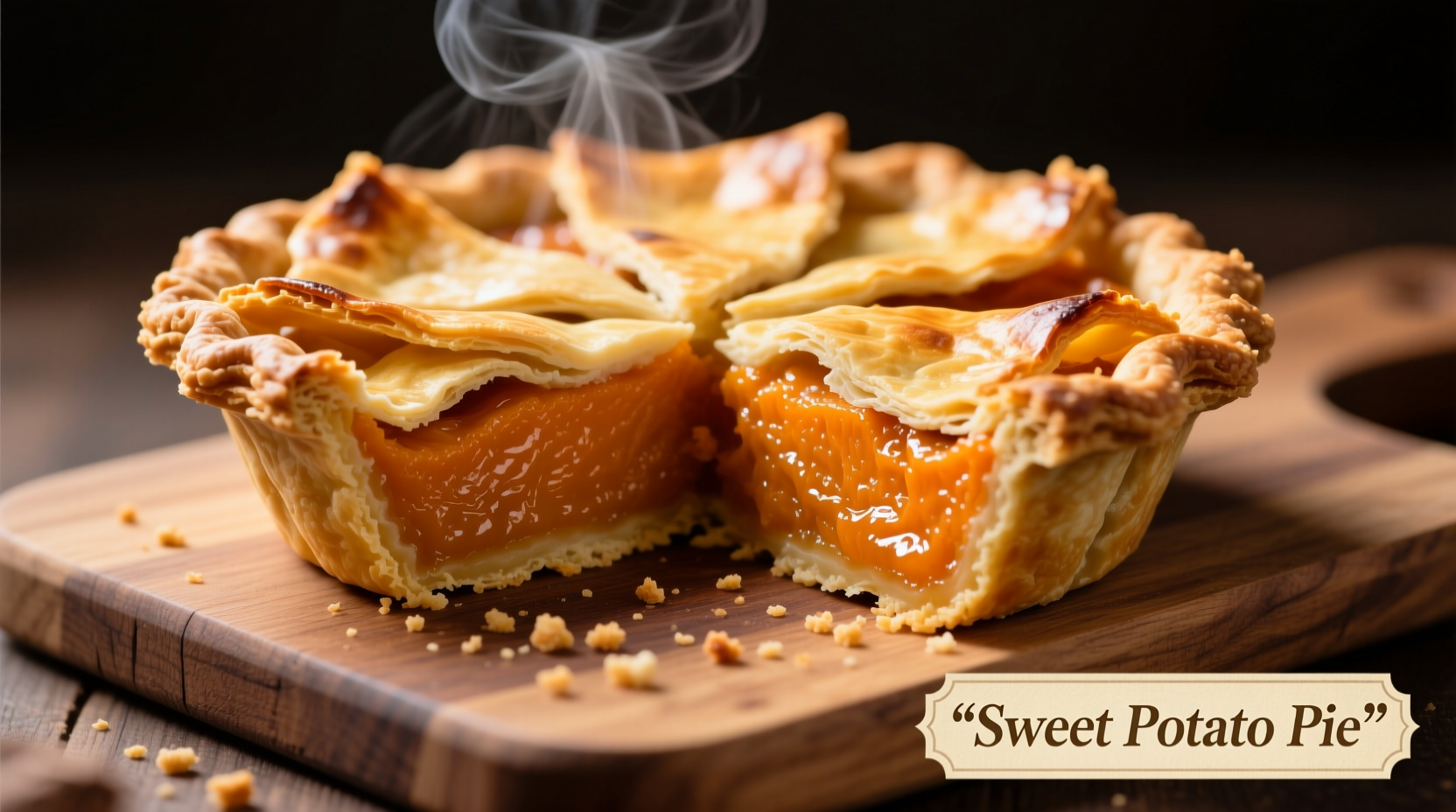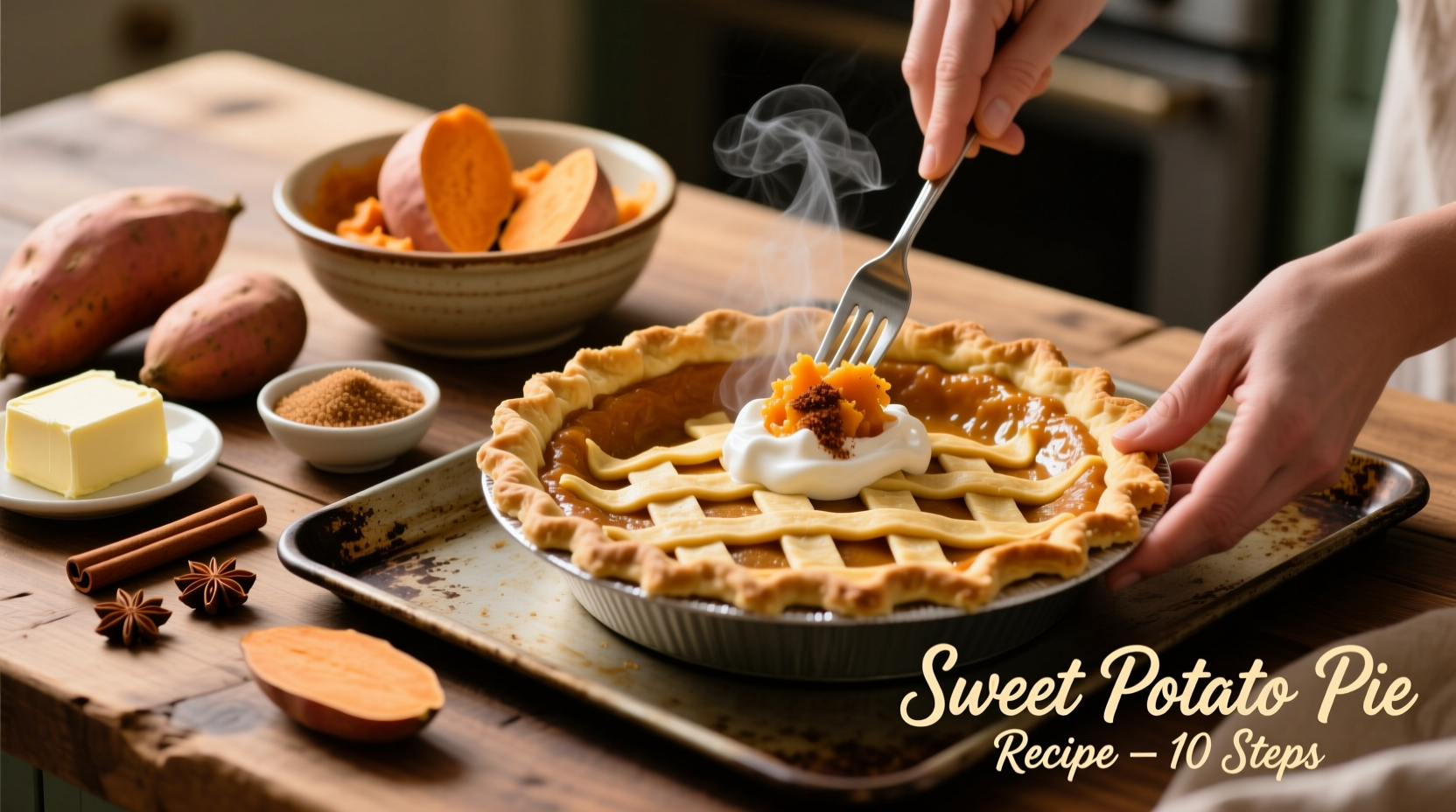The best sweet potato pie recipe combines 2 cups of smooth sweet potato puree, 3/4 cup sugar, 1 teaspoon cinnamon, 1/2 teaspoon nutmeg, 1/4 teaspoon cloves, 1/2 cup heavy cream, 2 large eggs, and a 9-inch unbaked pie crust. Bake at 350°F for 50-60 minutes until the center is set but slightly jiggly. This classic Southern dessert serves 8 and requires approximately 15 minutes of prep plus 1 hour baking time.
Why This Sweet Potato Pie Recipe Works Every Time
Creating the perfect sweet potato pie isn't just about following steps—it's understanding the science behind each ingredient and technique. As a culinary professional with years of experience teaching home cooks, I've refined this recipe to eliminate common pitfalls while preserving authentic Southern flavor. Whether you're baking for Thanksgiving or a weeknight treat, this guide delivers consistent results with professional-level quality.
Prep Like a Pro: Essential Equipment and Timing
Before you begin, gather these kitchen essentials to streamline your baking process:
- 9-inch pie dish (glass preferred for even baking)
- Electric mixer or whisk
- Potato masher or food processor
- Measuring cups and spoons
- Cooling rack
Allocate 75 minutes total: 15 minutes prep, 55 minutes baking, and 5 minutes cooling before serving. Starting with room temperature ingredients prevents curdling and ensures smooth incorporation.
Ingredient Selection: Quality Matters Most
The magic of exceptional sweet potato pie begins with ingredient selection. Not all sweet potatoes are created equal for baking:
| Sweet Potato Variety | Color | Sweetness Level | Best For Pie? |
|---|---|---|---|
| Garnet | Deep orange | High | Yes – ideal moisture content |
| Jewel | Orange | Moderate | Yes – widely available |
| Japanese | White | Mild | No – too dry for pie |
| Beauregard | Red-orange | Very high | Yes – excellent flavor |
According to USDA agricultural research, Garnet and Jewel varieties contain the optimal 22-25% natural sugar content for pie filling, creating that signature caramelized sweetness without excessive added sugar. Avoid canned sweet potato puree labeled "for pies" as these often contain thickeners that alter texture.
Step-by-Step Baking Process
Preparing the Sweet Potato Base
Peel and cube 2 pounds of sweet potatoes into 1-inch pieces. Boil until fork-tender (15-18 minutes), then drain thoroughly. Overlooking proper drainage causes a watery filling—the most common pie failure. For ultra-smooth texture, puree while warm using a food processor rather than a blender, which incorporates too much air.
Creating the Perfect Filling Mixture
In a large bowl, combine:
- 2 cups sweet potato puree (cooled)
- 3/4 cup granulated sugar
- 1/2 cup packed brown sugar
- 1/2 cup heavy cream (not half-and-half)
- 2 large eggs
- 2 tablespoons melted butter
- 1 teaspoon vanilla extract
- 1 teaspoon ground cinnamon
- 1/2 teaspoon ground nutmeg
- 1/4 teaspoon ground cloves
- 1/4 teaspoon salt
Whisk dry ingredients first, then gradually incorporate wet ingredients. The FDA recommends bringing eggs to room temperature before use to reduce salmonella risk in custard pies. Mix until just combined—overmixing incorporates air bubbles that cause cracking during baking.
Baking Science: Temperature and Timing
Pour filling into a standard 9-inch unbaked pie crust. Bake at 350°F following this precise timeline:
- 0-25 minutes: Crust sets while filling begins to cook
- 25-45 minutes: Critical setting phase—edges firm first
- 45-55 minutes: Center should jiggle slightly when nudged
Insert an instant-read thermometer into the center—175°F indicates perfect doneness. Higher temperatures cause curdling; lower temperatures yield runny filling. This precise temperature guidance comes from the American Egg Board's custard baking research.

Avoiding Common Pitfalls
Even experienced bakers encounter these issues. Here's how to prevent them:
- Cracking surface: Overbaking or rapid cooling. Remove pie when center still jiggles slightly and cool gradually at room temperature.
- Soggy bottom crust: Blind bake crust for 10 minutes before adding filling, or sprinkle bottom with 1 tablespoon breadcrumbs.
- Watery filling: Insufficiently drained potatoes or inaccurate measurements. Measure puree after draining, not before.
Serving and Storage Guidelines
For optimal flavor development, refrigerate overnight before serving. The National Center for Home Food Preservation confirms sweet potato pie remains safe for 3-4 days refrigerated. Freeze slices individually wrapped for up to 2 months—thaw in refrigerator before serving. Always reheat to 165°F for food safety when serving leftovers.
Variations for Dietary Needs
Adapt this classic recipe while maintaining structural integrity:
- Vegan option: Substitute eggs with 1/2 cup aquafaba + 1 tablespoon cornstarch; use coconut cream instead of dairy
- Lower sugar: Reduce total sugar to 1/2 cup and add 1/4 cup maple syrup for depth
- Nut-free version: Replace pecans in topping with toasted oats for crunch
Remember that sugar plays a structural role in custard pies—reducing beyond 50% of original amount may compromise texture.
Perfect Pairings and Presentation
Elevate your sweet potato pie with these professional touches:
- Top with freshly whipped cream (never canned) flavored with bourbon or orange zest
- Serve with a scoop of cinnamon ice cream for temperature contrast
- Garnish with candied pecans or a dusting of cinnamon sugar
- Pair with strong coffee or dessert wine like Tawny Port
For holiday presentations, create a lattice crust top or use cookie cutters to make decorative pastry shapes for the center.











 浙公网安备
33010002000092号
浙公网安备
33010002000092号 浙B2-20120091-4
浙B2-20120091-4